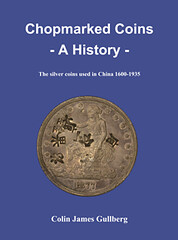
PREV ARTICLE
NEXT ARTICLE
FULL ISSUE
PREV FULL ISSUE
BOOK REVIEW: CHOPMARKED COINS: A HISTORY
Michael E. Marotta submitted this review of Colin Gullberg's new work on chopmarked coins. Thanks!
-Editor
Chopmarked Coins: A History; the silver coins used in China 1600-1935 by Colin James Gullberg (iAsure Group JEAN Publications, June 2014, 187 pages, 8-1/2 x 11, color ill., $40 + S&H). According to the author, this is only the second English language book on chopmarks. The previous standard was the catalog of the Frank Marvin Rose Collection from 1987. Michael Chou and Peter Chou purchased both the Rose collection, which won Best of Show, at the ANA in 1991, and the rights to that publication. Michael Chou also provided the venture capital for this new book. Chapter 1: “The History of Silver in China” is the core of this work, running 100 pages. The narrative is supported by a wealth of illustrations organized chronologically by the first year of issue. The 1732 Mexican Pillar Dollar is exemplified with a 1763 issue. A British East India Company rupee from 1879 stands for the series which began in 1862. Most of the coins come from Gullberg’s collection. However, many were reshot from the original Rose inventory. Other sources include the British Museum and Stacks Bowers. The narrative is really a history of global trade and commerce because the world went to China for tea and silk and other commodities. Gullberg’s essay is supported by footnote references to standard works such as Sargeant and Velde’s Big Problem of Small Change, the works of Eduard Kann, and of course the Krause & Mishler Standard Catalog of World Coins. In addition, Gullberg drew on personal contacts in Taiwan who opened their archives for him. Among the illustrations are reproductions from a “shroff’s” (money changer’s) handbook from about 1890. The bibliography of sixty sources is at the back. Gullberg explains the types of chopmarks–large, small, incuse, and relief—and attempts a taxonomy of time and place by series. For example: “To recap, very broadly small chops seemed to dominate from the cob period until around 1810. After 1820 large chops dominated until about 1910, when small chops returned. Pillar dollars are found with both, indicating that either large chops were also used in the 1730-70 period or these pillar dollar [sic] survived until after the 1820s, when silver prices were rising…” (page 118).
Toward the end the book has three sections on counterfeits: genuine chops on fake coins; fake chops on fake coins; fake chops on genuine coins. Those follow a section on counterstamps, damage, and other things that are not chopmarks. Gullberg claims that Hans F. Schulman, otherwise respected as a founder of both the PNG and IAPN, manufactured hundreds of fakes with a set of genuine chops he had acquired. He punched US Peace dollars, and other twentieth century world silver crowns. A lot of 50 was offered by The Money Company in their May 20, 1985 sale.

In the Introduction, Colin Gullberg explains that he had some exposure to coins and stamps as a child because his father, a Canadian attached to the US air defense, NORAD, often traveled. However, he only became aware of chopmarks in 2006. With a degree in English, he moved to Taiwan to teach. Taking his son to a coin store, he saw his first examples. He pursued the coins, and then founded the Chopmark Collectors Club, an ANA member society. The book is for sale directly from the author. Send an email to Colin Gullberg chopmarknews@gmail.com to make arrangements. Payment is usually via Paypal. Gullberg lives in Taiwan but he has an associate stateside who helps with the Chopmark Collectors Club.
To read the earlier E-Sylum article, see:
NEW BOOK: CHOPMARKED COINS - A HISTORY
(www.coinbooks.org/esylum_v17n27a03.html)
The Numismatic Bibliomania Society is a non-profit organization promoting numismatic literature. See our web site at coinbooks.org. To submit items for publication in The E-Sylum, write to the Editor at this address: whomren@gmail.com To subscribe go to: https://my.binhost.com/lists/listinfo/esylum All Rights Reserved. NBS Home Page Contact the NBS webmaster 
|

